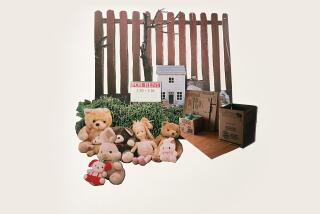Distant AIDS Storm Drops Rain Just Next Door
I was about to get into my car the other day when a neighbor came down the driveway and said, “I want to talk to you about a story. I have AIDS.”
She said it without either preamble or high drama, but rather in the unembellished manner of a stranger commenting on the weather.
For a moment, I hesitated, not quite certain I had heard her correctly, but then she added that she had been HIV-positive for 10 years.
It didn’t make sense. This was a woman I had seen pass our house off and on for the past 17 years, a pert and freckled advocate of good health, walking her dogs or strolling with her husband.
AIDS? This woman? In my neighborhood?
Her name is Toni Donovan and she lives not five minutes away in a spacious house of wood and glass and sunshine, surrounded by a garden she carved with pick and shovel out of the hard soil of a hillside.
“It isn’t just my story,” she was saying on that bright and eerie day. “So many others are in my position. I’m too rich to get help and too poor to afford all the drugs I need to stay alive.”
The moment was stamped on my memory with the force of a sledgehammer. Not only because she seemed an unlikely candidate for AIDS, but also because here was a metaphor for the swift spread of a terrible disease.
Like a prowler in the night, AIDS had crept into a house down the block, and I was shaken by its proximity.
*
Much has been written of the disease in terms of celebrityhood. Rock Hudson first and then Magic Johnson and Elizabeth Glaser and, most recently, boxer Tommy Morrison. We respond to the plight of the famous because of who they are, but lack empathy because they’re distant.
By the same token, AIDS casualty figures float by us unnoticed in a flood tide of numbers--311,000 dead nationwide, 85,000 in California, 20,000 in L.A. County--because they, too, are remote. The victims of the disease always seem to be someone else, somewhere else.
But then suddenly it’s next door and that’s different. The plague we once called a gay cancer is just a shady lane away.
A slight woman of 57, Donovan was discovered to be HIV-positive in 1986. So was the man she had married a year earlier. They learned of the virus in routine tests and watched their lives unravel.
Richard, her husband, was a strapping 6-foot-3, an outdoor man who, like Donovan, had been divorced for many years. They met while skiing and, as Donovan puts it, “we fell in love like teenagers.”
I often saw them walking down a hill past our house, alone in the glow of their relationship. Love between two people was never more obvious. How was anyone to know of their suffering? They had become children of a storm gathering over the world.
Sometime during their single lives, one or the other, or both, had been infected with the virus that causes AIDS. Both had lovers before meeting each other.
Richard worked up until a month before he died six years ago, drained by the disease but determined to keep his health insurance active. His hospital bills alone amounted to more than $200,000.
And now his widow faces the unknown without him.
*
It isn’t that she is without resources. Disability checks and a small income from stock purchases keep her basic bills paid. They also keep her from qualifying for Medi-Cal. Her income exceeds its limits.
Medicare, for the moment, is also out. She can’t receive it until she’s been on disability for two years and five months. She still has 17 months to go. “By then,” she says, “I could be dead. Is that what they want?”
Her parents, both in their 80s, are spending their retirement money to keep their only daughter alive. That amounts to anywhere from $2,000 to $3,000 a month. A new drug, a protease inhibitor, alone costs $365 per prescription.
Without family support, Donovan would be unable to afford the 23 pills she takes every day. Her T-cell count is 140. Normal is 1,000.
“You see where I am?” she asked metaphorically, sitting in a home that looks out on the paradise she’s created. “Not poor enough and not rich enough. I’m blessed with parents who would do anything for me. But what about all the others?”
They’re the 3,000 people with AIDS in L.A. County, an unknown number of whom face death without the resources to at least delay it. Some, like Donovan, caught in an economic twilight zone, risk losing everything to stay alive. Without family, she would have nothing.
I think about this as I leave her and walk the short distance to my home. I think about the dilemma of those in the midst of a storm that sweeps the world and about how close the clouds now seem that gather on the horizon.
*
Al Martinez can be reached through Internet at al.martinez@latimes.com
More to Read
Sign up for Essential California
The most important California stories and recommendations in your inbox every morning.
You may occasionally receive promotional content from the Los Angeles Times.










